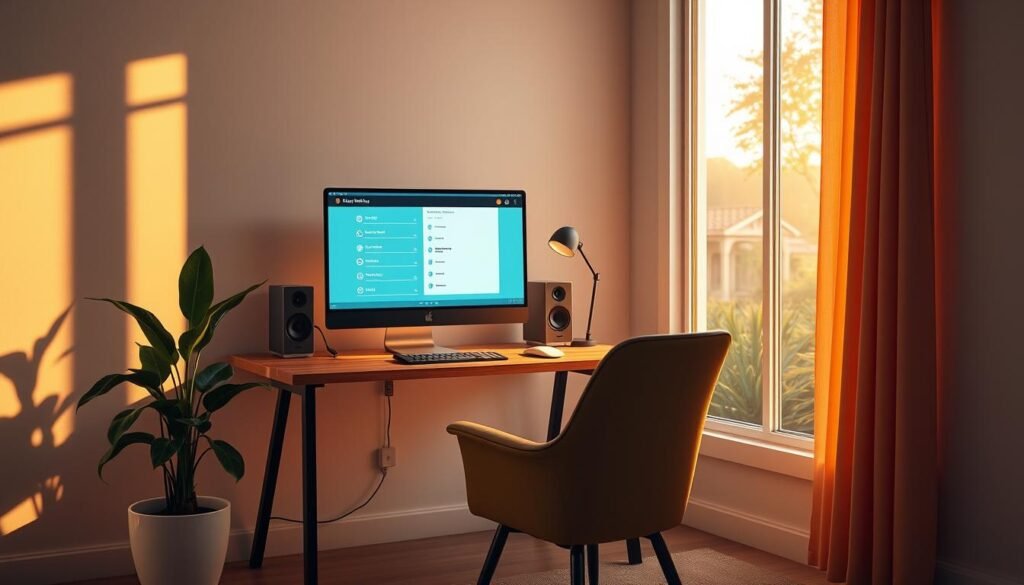About 12% of adults in the U.S. will face social anxiety in their lives. This condition greatly affects daily life, including work and schooling. Many people with this disorder fear being judged, making them avoid social events.
It’s vital to spot social anxiety signs early. The social anxiety disorder test can show how it affects you. Nearly 90% of those impacted dodge social gatherings. Spotting this trend is key to seeking expert advice. This anxiety screening test helps pinpoint whether professional help is needed.
The DSM-5-TR criteria based test gives clear mental health insights. It reveals the dread of social scenes or fear of shame. Understanding this can spur action. It’s about more than relief—it’s getting back missed life chances.
Key Takeaways
- Social anxiety affects about 7% of the population, signaling a widespread issue.
- Identifying symptoms early can lead to improved quality of life.
- The social anxiety disorder test is a valuable tool for self-assessment.
- Non-professional screening tools should complement, not replace, professional diagnosis.
- A significant number of individuals avoid social situations, limiting life experiences.
What is Social Anxiety Disorder?
Social anxiety disorder, once known as social phobia, impacts millions in the United States. It causes a strong fear of being judged or embarrassed in social settings. This condition usually starts in childhood or adolescence, with 75% of cases appearing before age 16. It makes social interactions hard for those affected.
Defining Social Anxiety Disorder
It’s important to understand what social anxiety disorder involves. People with it fear being negatively judged in social situations. They may avoid things like speaking publicly or meeting new people. With around 15 million adults in the U.S. affected, raising awareness is key. For those worried about social fears, taking a social anxiety test may help them explore their feelings more.
Common Symptoms of Social Anxiety Disorder
People with social anxiety experience both emotional and physical problems. They often feel a deep fear of negative judgment.
- Intense fear of being evaluated negatively
- Avoidance of social gatherings
- Physical symptoms like sweating, blushing, or trembling
- Trouble speaking in public or joining in conversations
- Constant worry about future social events
Research shows these individuals may avoid social situations 30% to 50% of the time. This can really affect their daily lives. It can make personal and work growth hard.
Knowing about social anxiety disorder leads to early help and treatment. Support and professional services are key for improvement. They help those with social phobia get better socially and emotionally.
The Importance of Taking the Social Anxiety Disorder Test
It’s vital to screen for social anxiety. This condition affects 5% to 10% of people worldwide. Identifying it early can greatly improve life quality. Many notice symptoms before turning 20 but might not link them to social anxiety disorder. A test can be a key first step in acknowledging these issues and seeking aid.
Why Screen for Social Anxiety?
Screening lets individuals think about their social experiences and voice their worries. People with social anxiety often fear upcoming social events. This fear might make them skip these events. Skipping social activities can damage both personal and work relationships. Tools like the social anxiety self-assessment help people understand their symptoms and notice patterns that need attention.
Identifying Symptoms Early
Spotting symptoms early can change how social anxiety disorder is handled. Tools such as the Liebowitz Social Anxiety Scale measure symptom severity. This can point people toward the right treatment. Recognizing symptoms, whether they’re mild or severe, lets people get help sooner. While mild symptoms may not stop someone from joining in social events, severe anxiety can. That’s why screening is crucial for starting discussions with mental health experts.

Understanding the Social Anxiety Disorder Test
The online social anxiety test helps determine how anxiety affects a person in social situations. It uses a bunch of questions to measure anxiety levels. This helps people understand the impact on their daily lives and relationships.
How the Test Works
The test for social anxiety disorder includes about 20 questions. These questions assess how comfortable someone feels in social settings. Users report their feelings about activities like public speaking and attending parties. This method offers clear insight into their anxiety level. It guides them to the right support and resources.
Types of Questions Asked in the Test
The questions mainly address discomfort and avoidance. Here are the main topics explored:
- Feelings of discomfort when being the center of attention.
- Responses to situations requiring public speaking.
- Reactions to social invitations and gatherings.
- Physical symptoms experienced in social situations, such as blushing or rapid heartbeats.
- Perception of others’ judgments and fears of negative evaluation.

Who Should Take the Social Anxiety Disorder Test?
If you wonder how you react in social settings, think about this test. It helps adults who feel uneasy in places like stores, parties, or even small talk. It’s about knowing if your worry is more than just being shy. This can help you see your mental state more clearly.
Target Audience
The test is made for adults facing social anxiety in everyday life. It points out if anxiety affects your daily tasks. If these things sound like you, the test could be helpful:
- Feeling intense fear or worry in social settings
- Avoiding social gatherings or specific situations
- Experiencing physical symptoms like increased heart rate or sweating when meeting new people
- Having fewer friendships due to social anxiety
When to Consider Taking the Test
You might need this test if anxiety messes with your day-to-day life or friendships. If this has been going on for six months or more, it might be time to seek help. The test can give you a starting point for what to look into further. Check who should take the test for more about it.
Understanding your mental health struggles is key. Taking a social anxiety test can be the first move towards getting better. It can lead to useful talks with therapists. This is a step towards growth and better mental well-being.
How to Prepare for the Social Anxiety Disorder Test
Getting ready for the social anxiety test means knowing what will happen and fixing false beliefs about it. Understanding the question layout helps reduce worry. It makes giving true answers easier.
What to Expect During the Assessment
You will see a list of statements about how you feel and act in social settings. The goal is to figure out your emotional state and how you deal with things. This will help you know yourself better.
Things examined include:
- Series of statements requiring responses on a scale
- Your feelings in different social situations
- Questions that check how you react and function daily
Common Misconceptions About the Test
Some people wrongly think the test will exactly diagnose social anxiety disorder. But, it’s really just a first step to understand social anxiety better. Knowing this helps you get ready for the test better.
Common false beliefs are:
- Thinking there’s a pass or fail; it’s all about self-assessment
- Believing test results tell the whole story—more evaluation by a mental health expert may be required
- Viewing the test as proof of a lasting condition instead of current feelings and reactions

Interpreting Your Results
When you finish the social anxiety disorder test, you get scores that show how serious your anxiety is. It’s crucial to understand these social anxiety test results. This helps figure out what steps to take next. The score acts as a starting point for discussions with a healthcare expert.
Understanding Your Score
Scoring systems differ across tests. For example, the SPIN’s scores go from 0 to 68. Scores above 19 suggest possible social anxiety disorder. The Liebowitz Social Anxiety Scale (LSAS) measures fear and avoidance. It ranks anxiety from none to very severe.
- 0-20: No social anxiety
- 21-30: Mild social anxiety
- 31-40: Moderate social anxiety
- 41-50: Severe social anxiety
- 51-68: Very severe social anxiety
Scores help you understand how anxiety affects your daily life. Looking at tools like the Social Phobia Inventory gives more insight. It helps spot problem areas.
Next Steps Based on Your Results
After you get your scores, it’s time to seek professional advice. Cognitive-behavioral therapy (CBT) is very helpful. It’s endorsed by the National Social Anxiety Center (NSAC). They have therapists across the U.S., including Arizona and New York.
You might also explore self-help books on social anxiety. Reassessing with tools like the SPIN every two weeks can track improvement.
Available Resources for Social Anxiety
There are many ways to get help for social anxiety. Professional help can change the way you deal with this issue. Therapists and counselors offer personalized support. They use proven methods to help manage symptoms. The National Social Anxiety Center (NSAC) provides certified cognitive-behavioral therapy (CBT). This helps people deal with their anxiety effectively.
Professional Help and Treatment Options
There are different treatments available for social anxiety:
- Cognitive-Behavioral Therapy (CBT) – This effective method targets negative thoughts and actions.
- Medication – There are medicines that help control symptoms.
- Group Therapy – You can share and learn in a group setting.
- Teletherapy – Online sessions make it easy for those who can’t meet in person.
Finding the right therapist is a big step in dealing with social anxiety. Websites like Psychology Today help you find experts near you. They make sure you get the help you need.
Online Social Anxiety Tests and Self-Assessments
The internet has many tools for understanding anxiety. Self-tests, like the Liebowitz Social Anxiety Scale, offer insight. They help you understand your situation better. This encourages steps towards getting help. Online resources guide you to helpful strategies. They are a great start to better mental health.
Test for Social Anxiety: Related Assessments and Tools
There are more ways to test for social anxiety beyond the well-known methods. Tests like the Social Anxiety Quiz and Social Phobia Assessment offer more insights. They look at anxiety from various angles to better understand symptoms and trends.
Social Anxiety Quiz
The Social Anxiety Quiz is easy to take and helps people think about how they act and feel in social settings. It’s not for diagnosing, but it’s a good starting point for those curious about their own experiences. Questions often touch on how comfortable someone feels in social situations and if they tend to avoid them.
Social Phobia Assessment
This assessment has a more detailed approach, focusing on physical symptoms and fears of social interaction. It helps figure out how severe the anxiety is and how it affects someone’s life. Using these tools can really help in understanding one’s feelings and concerns.
Conclusion
In the realm of mental health, understanding social anxiety disorder is crucial. It affects about 7% of the U.S. population each year. This impacts daily activities greatly. Taking a test can be the first step toward identifying symptoms. This helps people decide if they need more help.
Increasing awareness about social anxiety is important. About 30% of folks experience major challenges because of it. Treatments like cognitive-behavioral therapy help a lot, benefiting up to 75% of those who try it. It’s key to reach out for help and improve your life quality.
Social anxiety disorder doesn’t have to control your life. The test for it and knowing what it means opens up help and better coping methods. Understanding it helps overcome fear in social spots. Gaining knowledge is your first move towards a happier, more active life.